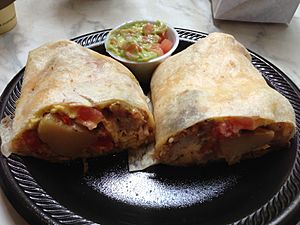Machaca facts for kids

Pork machaca, eggs and potatoes wrapped in a tortilla, served with guacamole
|
|
| Type | Dried meat |
|---|---|
| Place of origin | Mexico |
| Region or state | Northern Mexico |
| Main ingredients | Beef or Pork |
| Ingredients generally used | Chilis and other spices |
Machaca is a special kind of dried meat, usually beef or pork. It's often spiced and then rehydrated, meaning water is added back to it. This makes it ready to be used in many tasty dishes.
Machaca is very popular in Northern Mexico and the Southwestern United States. You can often find it in grocery stores in these areas. If dried machaca isn't available, people sometimes use slow-cooked, shredded beef brisket or skirt steak instead.
You can enjoy machaca in many ways. It's often rolled into flautas, tacos, or burritos. It can also be served on a plate with eggs, onions, and different kinds of chili peppers. Machaca is almost always eaten with large flour tortillas. These tortillas can be quite big, up to 20 inches across! A very popular breakfast or brunch meal is machaca with eggs. This dish is especially famous among miners in the state of Chihuahua, Mexico.
This delicious dish is mainly known in northern Mexico. It's also popular in the southern parts of U.S. states like Arizona, California, and New Mexico. In central and southern Mexico, it's not as well-known.
The Story of Machaca
Machaca started out as a way to preserve meat. People would dry beef or pork and add spices. Then, when they wanted to eat it, they would add water to make it soft again. After that, they would pound the meat to make it even more tender. This dried meat was then used to make many different meals.
Drying meat is one of the oldest ways to keep food from spoiling. Ranchers and cowboys in northern Mexico were the ones who developed the idea of drying beef with chilis and other local spices. This helped them store meat for a long time, especially when they were out on the range.
Later, when refrigeration became common, people didn't need to dry meat for preservation as much. Today, most dried beef sold in the United States is called jerky. In Mexico, however, dried machaca is still sold for cooking and as a snack, especially in the northern regions.
Nowadays, many machaca dishes are made differently. Instead of using dried meat, people often use beef that has been cooked until it's very tender. Then, it's shredded and cooked in its own juices. The final dish can be soupy, dry, or somewhere in between. In places like Tucson, Arizona and areas further south, machaca is almost always prepared dry. This dry version tastes and feels very similar to the original dish made from dried meat. Sometimes, machaca is also called Carne seca in parts of the Southwest U.S. and Sonora, Mexico.

